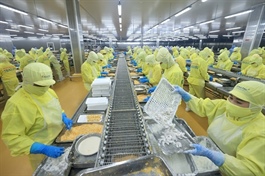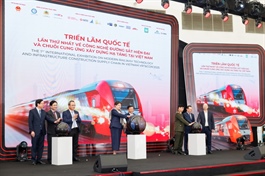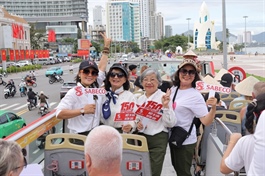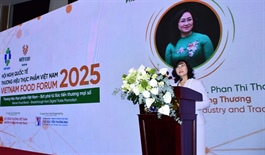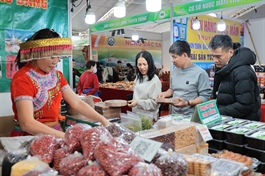HCM City’s coastal commune eyes role as southern green petrochemical hub
HCM City’s coastal commune eyes role as southern green petrochemical hub
The city has reaffirmed the goal of developing Long Sơn Commune into a “green and modern petrochemical centre in the South”.
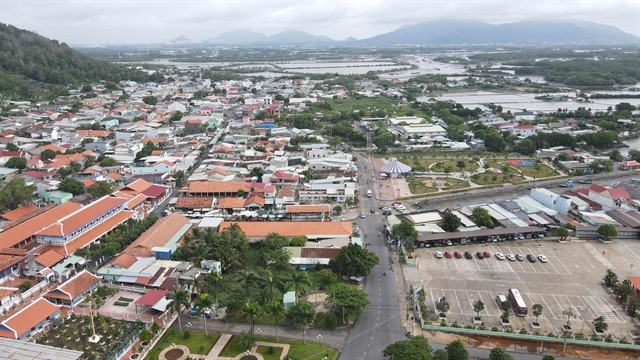
A view of Long Sơn Island Commune, poised to emerge as a southern hub for green refining and petrochemical industries. VNA/VNS Photo Huỳnh Sơn |
Once a quiet island of mangroves and fishing villages, Long Sơn, the newly enlarged coastal commune of HCM City, is now transforming into a dynamic industrial zone – a place where traditional livelihoods meet the promise of green industry.
Located between the bustling tourism city of Vũng Tàu and the Cái Mép -Thị Vải deep-sea port cluster, Long Sơn was long isolated by rivers and wetlands.
For generations, its residents relied on small-scale fishing and traditional salt-making – their lives shaped by the rhythm of tides rather than trade.
The construction of key bridges – Ba Nanh in 2000, Gò Găng in 2008, and Chà Và in 2011 – marked a turning point, connecting the island to the mainland and opening the door to transformation.
Covering 56.7 square kilometres and home to nearly 17,800 residents, Long Sơn officially became a commune incorporated into HCM City in July 2025.
With its strategic location near major waterways leading to Gành Rái Bay and the Cái Mép - Thị Vải Port Complex, the commune has been identified by both central and local authorities as a key area for national defence and industrial development – particularly in refining, petrochemicals, and supporting industries.
Fuel for growth
At the heart of Long Sơn’s transformation stands the Long Sơn Petrochemical Complex (LSP), developed by Thailand’s Siam Cement Group (SCG) – a project that redefines the skyline and ambitions of this once-sleepy island.
This national key project, launched in 2018, represents an investment of US$5.4 billion across 464ha.
Despite pandemic challenges, the complex was completed on schedule in 2023, began trial operations in early 2024, and resumed full commercial operations in August 2025 after a brief market-related suspension.
During a working visit in September, Nguyễn Văn Được, chairman of HCM City People’s Committee (the municipal government body), praised SCG’s commitment to innovation and sustainability.
He reaffirmed the city’s goal of developing Long Sơn into a “green and modern petrochemical centre in the South” and encouraged SCG to continue contributing to this vision.
According to Kullachet Dharachandra, SCG country director in Việt Nam and CEO of LSP, the company is investing an additional $500 million to build an ethane storage and supply system to diversify feedstocks and reduce greenhouse-gas emissions.
Once fully operational, the complex is expected to generate about $800 million in export revenue annually and contribute roughly $150 million in taxes to Việt Nam’s state budget.
Aligned with environmental, social, and governance (ESG) principles, LSP has also organised community programmes to support education, healthcare, and cultural preservation while promoting environmental protection across the commune.

A view of Long Sơn Island Commune, poised to emerge as a southern hub for green refining and petrochemical industries. VNA/VNS Photo Huỳnh Sơn |
Shaping a green future
Nguyễn Tấn Cường, secretary of Long Sơn Commune’s Communist Party Committee, said the commune was updating its master plan to align with the city’s post-merger development orientation, prioritising digital transformation and land clearance for major projects such as the 850ha Long Sơn Oil and Gas Industrial Park and the Nguyễn Phong Sắc Road expansion.
Long Sơn’s natural landscape – mangrove swamps, interlaced rivers, the culturally significant Ông Trần religion, and Nhà Lớn heritage complex – provides an ideal foundation for integrating eco-tourism with industrial growth.
Commune leaders envision Long Sơn as an eco-industrial and coastal urban zone that harmonises green industry, culture, and nature.
Nguyễn Trọng Thụy, chairman of the commune’s People’s Committee (the local government body), said its later urbanisation gave Long Sơn the advantage of “building more systematically and sustainably”.
“Our revised planning focuses on protecting natural resources, adapting to climate change, and ensuring harmony between development and preservation,” he said.
Under the new plan, the commune will conserve mangrove forests, develop a low-carbon eco-urban area on Gò Găng Island, and maintain traditional village clusters interwoven with modern urban spaces.
Cultural heritage sites such as Nhà Lớn, Đình Thần, Miễu Bà, and Long Sơn Pagoda, along with local festivals, will continue to be protected.
The commune is also witnessing strong investment momentum. New projects include the nearly VNĐ2 trillion ($76 million) Long Sơn International Port and a VNĐ240 billion ($9.1 million) industrial gas plant, both contributing to local economic growth and job creation.
Infrastructure upgrades – including Long Sơn - Cái Mép, Nguyễn Phong Sắc, and 28 April streets – are nearing completion.
The upcoming Gò Găng 2 and Chà Và 2 bridges will further improve regional connectivity, linking Long Sơn with the Cái Mép - Hạ Free Trade Zone, nearby industrial parks, and coastal tourism destinations in Vũng Tàu, Long Hải, and Hồ Tràm.
As Long Sơn’s comprehensive socio-economic picture takes shape, its vision of becoming a green industrial hub grows clearer.
With its revolutionary history and distinctive Ông Trần cultural heritage, the commune is steadily advancing towards its goal of becoming a modern, harmonious, and sustainable petrochemical centre in the southern region.
- 09:01 15/11/2025





